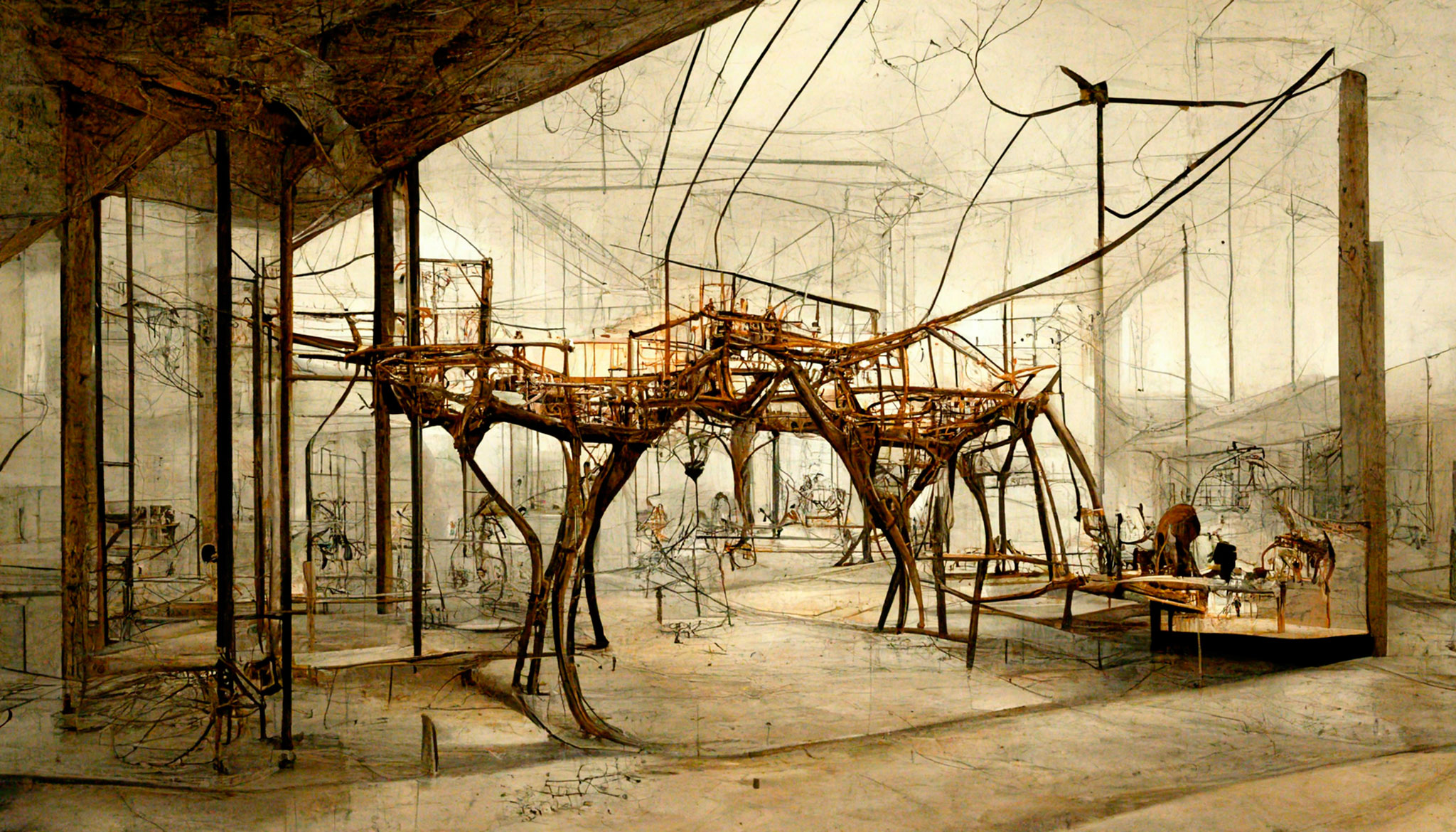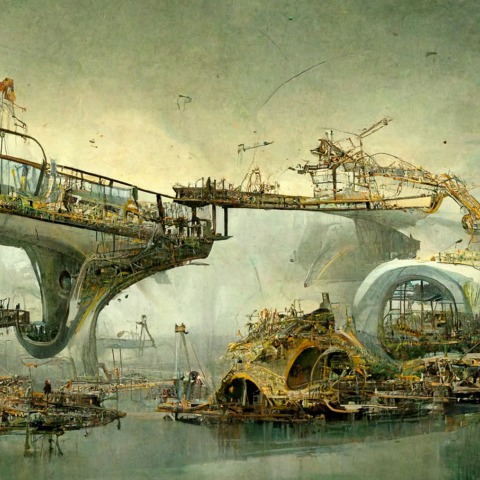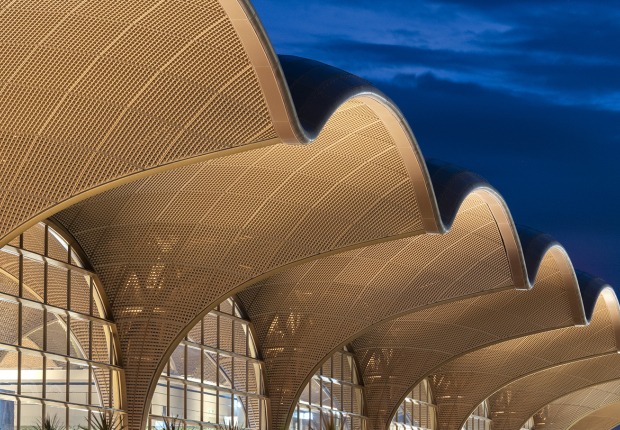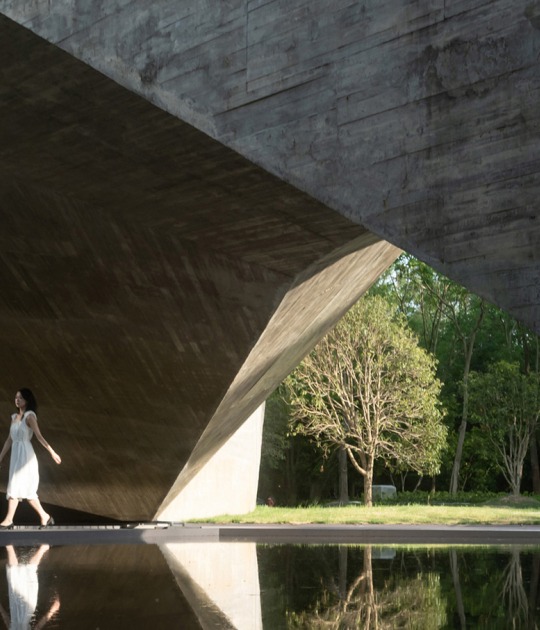Aladdin's Lamp: Artificial Intelligence, Architecture and Imagination
by Cesare Battelli
Not so long ago a new means of artistic and architectural experimentation appeared on the international scene, which has been given the name of Artificial Intelligence laboratories such as Dall-e and Mid journey among others. The AI works as a kind of online laboratory in which instead of having a list of commands to access as in the usual applications, you speak directly to a machine asking it to do whatever comes to mind. A bit like Aladdin's lamp. What initially looks like a simple and fun game, quite addictive among other things, actually hides an imaginative and hybridization potential like never seen before.
Although we are dealing with algorithms in a gigantic database, we have relegated to machines the highest level of human intelligence: imagination. Behind this word, widely used in common parlance, almost always associated with something unreal, lies a good part of the history of philosophy and art, so much so that the greatest lexicographers and thinkers have difficulty tracing its true origin.
It is known that in the first Latin translations of the ancient Greek (Aristotle), it is the word fantasy is translated as imagination. But how many kinds of imagination are there, what are the relations between fantasy and imagination, and are they the same thing?
These questions would require such a complex analysis that they cannot be developed in a few lines; I will limit myself to brief notes, starting with the etymology of the word image which recalls the double meaning of this term and (I quote M. Eliade) and therefore its double root: Imitator and mágia. A similar interpretation is also made by the Lutheran theologian Jakob Böhme, who identifies in imagination the root of Himmel (heaven) and magic. But it was above all through Renaissance Neoplatonism, its syncretic culture, that debates on these themes became heated, especially in the Florentine Academy under the leadership of Marsilio Ficino and one of his most illustrious disciples, Pico della Mirandola.

Theatre of memory (capsule version) by Cesare Battelli. Image courtesy of Cesare Battelli.

Noah's ark by Cesare Battelli. Image courtesy of Cesare Battelli.
We are situated in what is called the magical modernity, (which lasted until the 17th century) in which the transitive imagination (ratio by Ficino) assumed the fundamental role of connection between the macrocosm and the microcosm, between the sensible and the intelligible, marking the individual actions of the artists of the time (Alberti, Leonardo, Botticelli, etc.). The idea of the medieval Imago Mundi, to which, among other sources and many of them oriental, the Renaissance owes much, is transformed into Anima Mundi in the 15th century until becoming Theatrum Mundi in the 17th century, from which, gradually, the Neoplatonic fantastikon will be transformed into an artistic genre in itself and the imaginary a simulacrum of this image of the world that from the dawn of antiquity has been extended until Robert Fludd and the Cambridge school.
From then on, another modernity took shape, the scientific one, which will lead us, among many things, to intelligent machines, and the paradox that precisely from the most advanced technology we see ourselves, "volens noles", to retract these themes and probably what will be the season of imaginary or synaesthetic architecture.
The paradigm shift that occurred in that period, and which will give rise to the genre of imaginary-visionary art and architecture in the 18th century (Blake and Piranesi), already prefigured by the art of Monsu Desiderio and by the synaesthetic imagination of Giordano Bruno in philosophy almost a hundred years earlier, is not so far removed from the new paradigms, both spatial and design, that machines offer us through a more or less simple sequence of indications, i.e. verbal statements.

Noah's ark by Cesare Battelli. Image courtesy of Cesare Battelli.

Kangaroo Space by Cesare Battelli. Image courtesy of Cesare Battelli.
We now speak of machines as collaborators or co-authors in which you have to explain to them in a simple but extremely rigorous way what you want, even if you know that the machine's imagination is very different from the way things are imagined before they are elaborated by one of these laboratories. I prefer to think of a sequence of imaginaries between humans and machines at a delicate meeting point between intentions and digital elaborations.
These new paradigms go far beyond the simple visualization of unexpected, extremely rigorous, and realistic-looking things. They go far beyond the wonders of the possible.
The machine works on spaces and 'genetic inputs' (including the format itself, which can affect the whole, not just a simple framing) which, while presenting an infinite range of variants, each image is always different from the last. It is never repeated, but the germ, so to speak, is always the same. Continent and content are inverted, just as it is possible to merge the exterior and interior of space, the small and the large, etc.

Seahorse by Cesare Battelli. Image courtesy of Cesare Battelli.

Seahorse by Cesare Battelli. Image courtesy of Cesare Battelli.
This, which is ultimately a process of hybridization, can be placed perfectly on the borderline where the imagination as such acts, not to reveal something unreal but something possible, however strange some experiments may seem to us.
It is not a simple hybridization of, for example, an animal or something biological with architecture, but a fusion between the two, where both are visible at the same time, but as something completely unexpected. A meeting point between different worlds, which in essence would be a "complexio oppositorum".
Spaces can then become evocative, acquire the appearance of distant things that at the same time become close, of urban visions that are also interior spaces, architectures that are both defined and undefined at the same time. Different eras can even be brought together, evoking both the past and the future, so much so that I would dare to think of a 'syncreticguard', rather than a retro or an avant-garde. Not a simple game, then, but an extremely complex and fascinating repertoire that architects and artists will soon have to deal with.
by Cesare Battelli
Not so long ago a new means of artistic and architectural experimentation appeared on the international scene, which has been given the name of Artificial Intelligence laboratories such as Dall-e and Mid journey among others. The AI works as a kind of online laboratory in which instead of having a list of commands to access as in the usual applications, you speak directly to a machine asking it to do whatever comes to mind. A bit like Aladdin's lamp. What initially looks like a simple and fun game, quite addictive among other things, actually hides an imaginative and hybridization potential like never seen before.
Although we are dealing with algorithms in a gigantic database, we have relegated to machines the highest level of human intelligence: imagination. Behind this word, widely used in common parlance, almost always associated with something unreal, lies a good part of the history of philosophy and art, so much so that the greatest lexicographers and thinkers have difficulty tracing its true origin.
It is known that in the first Latin translations of the ancient Greek (Aristotle), it is the word fantasy is translated as imagination. But how many kinds of imagination are there, what are the relations between fantasy and imagination, and are they the same thing?
These questions would require such a complex analysis that they cannot be developed in a few lines; I will limit myself to brief notes, starting with the etymology of the word image which recalls the double meaning of this term and (I quote M. Eliade) and therefore its double root: Imitator and mágia. A similar interpretation is also made by the Lutheran theologian Jakob Böhme, who identifies in imagination the root of Himmel (heaven) and magic. But it was above all through Renaissance Neoplatonism, its syncretic culture, that debates on these themes became heated, especially in the Florentine Academy under the leadership of Marsilio Ficino and one of his most illustrious disciples, Pico della Mirandola.

Theatre of memory (capsule version) by Cesare Battelli. Image courtesy of Cesare Battelli.

Noah's ark by Cesare Battelli. Image courtesy of Cesare Battelli.
We are situated in what is called the magical modernity, (which lasted until the 17th century) in which the transitive imagination (ratio by Ficino) assumed the fundamental role of connection between the macrocosm and the microcosm, between the sensible and the intelligible, marking the individual actions of the artists of the time (Alberti, Leonardo, Botticelli, etc.). The idea of the medieval Imago Mundi, to which, among other sources and many of them oriental, the Renaissance owes much, is transformed into Anima Mundi in the 15th century until becoming Theatrum Mundi in the 17th century, from which, gradually, the Neoplatonic fantastikon will be transformed into an artistic genre in itself and the imaginary a simulacrum of this image of the world that from the dawn of antiquity has been extended until Robert Fludd and the Cambridge school.
From then on, another modernity took shape, the scientific one, which will lead us, among many things, to intelligent machines, and the paradox that precisely from the most advanced technology we see ourselves, "volens noles", to retract these themes and probably what will be the season of imaginary or synaesthetic architecture.
The paradigm shift that occurred in that period, and which will give rise to the genre of imaginary-visionary art and architecture in the 18th century (Blake and Piranesi), already prefigured by the art of Monsu Desiderio and by the synaesthetic imagination of Giordano Bruno in philosophy almost a hundred years earlier, is not so far removed from the new paradigms, both spatial and design, that machines offer us through a more or less simple sequence of indications, i.e. verbal statements.

Noah's ark by Cesare Battelli. Image courtesy of Cesare Battelli.

Kangaroo Space by Cesare Battelli. Image courtesy of Cesare Battelli.
We now speak of machines as collaborators or co-authors in which you have to explain to them in a simple but extremely rigorous way what you want, even if you know that the machine's imagination is very different from the way things are imagined before they are elaborated by one of these laboratories. I prefer to think of a sequence of imaginaries between humans and machines at a delicate meeting point between intentions and digital elaborations.
These new paradigms go far beyond the simple visualization of unexpected, extremely rigorous, and realistic-looking things. They go far beyond the wonders of the possible.
The machine works on spaces and 'genetic inputs' (including the format itself, which can affect the whole, not just a simple framing) which, while presenting an infinite range of variants, each image is always different from the last. It is never repeated, but the germ, so to speak, is always the same. Continent and content are inverted, just as it is possible to merge the exterior and interior of space, the small and the large, etc.

Seahorse by Cesare Battelli. Image courtesy of Cesare Battelli.

Seahorse by Cesare Battelli. Image courtesy of Cesare Battelli.
This, which is ultimately a process of hybridization, can be placed perfectly on the borderline where the imagination as such acts, not to reveal something unreal but something possible, however strange some experiments may seem to us.
It is not a simple hybridization of, for example, an animal or something biological with architecture, but a fusion between the two, where both are visible at the same time, but as something completely unexpected. A meeting point between different worlds, which in essence would be a "complexio oppositorum".
Spaces can then become evocative, acquire the appearance of distant things that at the same time become close, of urban visions that are also interior spaces, architectures that are both defined and undefined at the same time. Different eras can even be brought together, evoking both the past and the future, so much so that I would dare to think of a 'syncreticguard', rather than a retro or an avant-garde. Not a simple game, then, but an extremely complex and fascinating repertoire that architects and artists will soon have to deal with.






































































